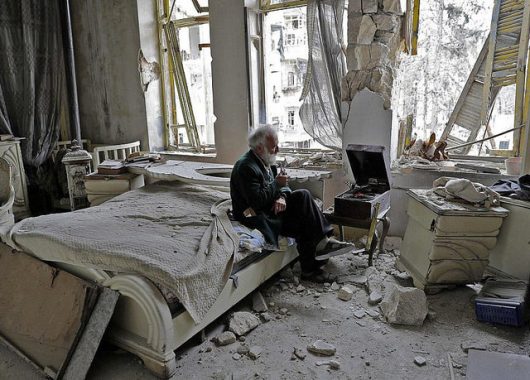The Most Dangerous Countries in the World
 As of January 2018, the State Department currently categorizes 11 countries with a level 4 travel advisory. The advisory recommends that U.S. citizens refrain from traveling to that individual country due to dangerous conditions. Level 4 travel warnings are issued for various reasons, which include terrorism, armed conflict, health, civil unrest and crime. The seven most dangerous countries in the world detailed here all have high poverty rates due to the unsafe and unstable living conditions in the country.
As of January 2018, the State Department currently categorizes 11 countries with a level 4 travel advisory. The advisory recommends that U.S. citizens refrain from traveling to that individual country due to dangerous conditions. Level 4 travel warnings are issued for various reasons, which include terrorism, armed conflict, health, civil unrest and crime. The seven most dangerous countries in the world detailed here all have high poverty rates due to the unsafe and unstable living conditions in the country.
The Most Dangerous Countries in the World
- Afghanistan
In recent years, Afghanistan has experienced prolonged armed conflict between NATO forces and domestic terrorist groups such as the Taliban and ISIL. Al-Qaida and other foreign terrorist organizations have maintained a presence in the conflict as well. Afghanistan’s capital, Kabul, continually faces the threat of terrorist attacks, which include suicide bombings, kidnappings and armed conflict. A portion of these attacks explicitly target government buildings, hotels, restaurants and other areas frequented by foreign visitors. - Syria
According to the State Department travel advisory for Syria, “No part of Syria is safe from violence. Kidnappings, the use of chemical warfare and aerial bombardment have significantly raised the risk of death or serious injury.” As of February 2012, the U.S. Embassy in Damascus has ceased all operations.Originally, the Syrian conflict began as an extension of the Arab Spring, which sought to remove Bashar al-Assad, Syria’s current president. Over the course of the last seven years, the nature of the conflict has changed with U.S., Turkish and Russian involvement. Armed conflict continues among multiple militia groups. As a result of the continued crisis, a large number of refugees have sought asylum in Europe, North America and other regions of the Middle East. It is unclear as to when a peace agreement can be reached between the current opposing forces.
- Yemen
With the removal of President Abd Rabuh Mansur Hadi by Huthi forces in 2015, Yemen has suffered from continuous internal conflict between tribal groups and political parties. As a consequence, Yemen’s infrastructure of medical facilities, schools, housing, power and water utilities have been massively damaged.Between April and July 2017, more than 400,000 cases of cholera were reported. During that same period, close to 2,000 individuals died of cholera. In 2016, the U.N. attempted to reach a peace agreement for the cessation of hostilities, which ultimately failed.Sporadic fighting persists within Yemen, along with a domestic presence of terrorist groups such as al-Qaida.
- Mali
Violent crime and terrorism are prevalent issues in northern and central Mali. The State Department warns foreign visitors that both kidnapping and armed robbery are major concerns when traveling to the country. Hotels, nightclubs, places of worship and restaurants are frequent places for domestic terrorist attacks.It is advised to avoid traveling at night due to random police checkpoints and illegal roadblocks. Seasonal holidays have also seen increased violent activity. - Somalia
Somalia has seen great progress in recent years with the creation of a 275-member parliament and a presidential election in 2012. However, the continued presence of the terrorist group al-Shabaab, an al-Qaida affiliate, presents dangerous conditions for Somali citizens and foreign visitors.On October 14, 2017, Somalia saw its deadliest attack ever recorded in its prolonged war against Islamic extremists. Two truck bombs were detonated in the capital city of Mogadishu, resulting in approximately 280 casualties and more than 300 wounded. Illegal roadblocks are common throughout the country, posing dangers to travelers. Also, the issue of piracy continues to threaten the security of those traveling by sea.
- Central African Republic
In its report on the Central African Republic, the State Department warns visitors of crime and civil unrest. Currently, large areas of the country are under the control of armed groups, preventing safe travel. Notable violent crimes are listed, such as armed robbery, aggravated battery and homicide. The fragmented nature of the country is a result of a civil war launched in 2013 which ousted President Francois Bozize, who seized power through a military coup in 2003.As of 2016, the current president, Faustin-Archange Touadera, has sought to establish peace with the various rebel groups through a program which aims to reintegrate the armed groups into society.
- Iraq
Upon the removal of Saddam Hussein by U.S.-led coalition forces, an Iraqi government was formally established. However, Iraq has continued to be a hotbed for armed conflict and terrorist activity, most notably the invasion of Mosul by the forces of ISIS and their eventual defeat in late 2017. Iraq’s capital, Baghdad, continues to be the target of suicide bombings and other terrorist attacks. Due to the current security crisis throughout Iraq and the civil war in neighboring Syria, Iraq remains one of the most dangerous countries in the world.As the security situation remains largely unsolved, the State Department continues to list Iraq as a level 4 travel warning, urging potential visitors to avoid travel for the foreseeable future.
Primarily, the current security climate in these states is a direct result of various types of armed conflict. As a result of armed conflict, critical health issues have also arisen. However, this is cause for hope. Continued support from the world’s wealthiest nations in the form of development and aid can help bring armed conflict to an end. A different future is possible, one in which these war-torn nations will no longer be classified as the most dangerous countries in the world.
– Colby McCoy
Photo: Flickr
